Use of biotinylated plasmid DNA as a surrogate for HSV DNA to identify proteins that repress or activate viral gene expression
- PMID: 23223531
- PMCID: PMC3529035
- DOI: 10.1073/pnas.1218783109
Use of biotinylated plasmid DNA as a surrogate for HSV DNA to identify proteins that repress or activate viral gene expression
Abstract
ICP0, a key herpes simplex virus regulatory protein, functions first in the nucleus and then in the cytoplasm. The duration of its nuclear sojourn in cells transfected with DNA and then infected is related to the quantity of transfected DNA. Furthermore, ICP0 transactivates both viral genes and genes encoded by the transfected DNA. The data support the hypothesis that ICP0 is retained in the nucleus until it completes the replacement of repressive chromatin with effector proteins that enable transcription of both DNA templates.To identify the effector proteins, we transfected cells with biotinylated DNA encoding a nonviral gene and then infected the cells with wild-type virus. Proteins bound to transfected biotinylated plasmid recovered from mock-treated and infected cells were identified using mass spectrometry followed by appropriate database search. The transfected DNA from mock-infected cells yielded proteins associated with repression, whereas DNA recovered from infected cells included proteins known to enable transcription and proteins that have not been previously associated with that role. To test the hypothesis that the proteins hitherto not known to associate with viral gene expression are nevertheless essential, we tested the role of the DEAD-box helicase Ddx17. We report that Ddx17 plays a critical role in the expression of early and late viral genes. Thus, biotinylated DNA recovered from transfected infected cells can function as a surrogate for viral DNA and is a rich source of proteins that play a role in viral gene expression but which have not been previously identified in that role.
Conflict of interest statement
The authors declare no conflict of interest.
Figures
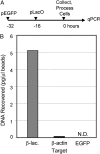
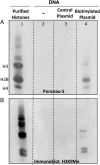
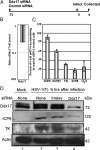
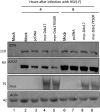
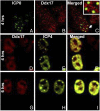
Similar articles
-
Herpes simplex virus type 1 ICP0 plays a critical role in the de novo synthesis of infectious virus following transfection of viral DNA.J Virol. 1989 Nov;63(11):4579-89. doi: 10.1128/JVI.63.11.4579-4589.1989. J Virol. 1989. PMID: 2552142 Free PMC article.
-
Herpes simplex virus type 1 ICP0 regulates expression of immediate-early, early, and late genes in productively infected cells.J Virol. 1992 May;66(5):2904-15. doi: 10.1128/JVI.66.5.2904-2915.1992. J Virol. 1992. PMID: 1313909 Free PMC article.
-
Mutations Inactivating Herpes Simplex Virus 1 MicroRNA miR-H2 Do Not Detectably Increase ICP0 Gene Expression in Infected Cultured Cells or Mouse Trigeminal Ganglia.J Virol. 2017 Jan 3;91(2):e02001-16. doi: 10.1128/JVI.02001-16. Print 2017 Jan 15. J Virol. 2017. PMID: 27847363 Free PMC article.
-
The regions important for the activator and repressor functions of herpes simplex virus type 1 alpha protein ICP27 map to the C-terminal half of the molecule.J Virol. 1989 Nov;63(11):4590-602. doi: 10.1128/JVI.63.11.4590-4602.1989. J Virol. 1989. PMID: 2552143 Free PMC article.
-
Cellular Transcriptional Coactivator RanBP10 and Herpes Simplex Virus 1 ICP0 Interact and Synergistically Promote Viral Gene Expression and Replication.J Virol. 2016 Jan 6;90(6):3173-86. doi: 10.1128/JVI.03043-15. J Virol. 2016. PMID: 26739050 Free PMC article.
Cited by
-
Codon usage regulates human KRAS expression at both transcriptional and translational levels.J Biol Chem. 2018 Nov 16;293(46):17929-17940. doi: 10.1074/jbc.RA118.004908. Epub 2018 Oct 1. J Biol Chem. 2018. PMID: 30275015 Free PMC article.
-
Effect of Loss-of-function of the Herpes Simplex Virus-1 microRNA H6-5p on Virus Replication.Virol Sin. 2019 Aug;34(4):386-396. doi: 10.1007/s12250-019-00111-6. Epub 2019 Apr 24. Virol Sin. 2019. PMID: 31020575 Free PMC article.
-
Interactome and Ubiquitinome Analyses Identify Functional Targets of Herpes Simplex Virus 1 Infected Cell Protein 0.Front Microbiol. 2022 Apr 18;13:856471. doi: 10.3389/fmicb.2022.856471. eCollection 2022. Front Microbiol. 2022. PMID: 35516420 Free PMC article.
-
Two Thalamic Regions Screened Using Laser Capture Microdissection with Whole Human Genome Microarray in Schizophrenia Postmortem Samples.Schizophr Res Treatment. 2020 May 31;2020:5176834. doi: 10.1155/2020/5176834. eCollection 2020. Schizophr Res Treatment. 2020. PMID: 32566292 Free PMC article.
-
RNA helicases, DDX5 and DDX17, facilitate lytic reactivation of gammaherpesviruses.PLoS Pathog. 2025 Apr 21;21(4):e1013009. doi: 10.1371/journal.ppat.1013009. eCollection 2025 Apr. PLoS Pathog. 2025. PMID: 40257982 Free PMC article.
References
-
- Roizman B, Knipe DM, Whitley RJ. In: Fields’ Virology, Herpes simplex viruses. 5th Ed. Knipe DM, et al., editors. New York: Lippincott-Williams and Wilkins; 2007. pp. 2501–2601.
-
- Roizman B, Zhou G, Du T. Checkpoints in productive and latent infections with herpes simplex virus 1: Conceptualization of the issues. J Neurovirol. 2011;17(6):512–517. - PubMed
Publication types
MeSH terms
Substances
Grants and funding
LinkOut - more resources
Full Text Sources
Miscellaneous

